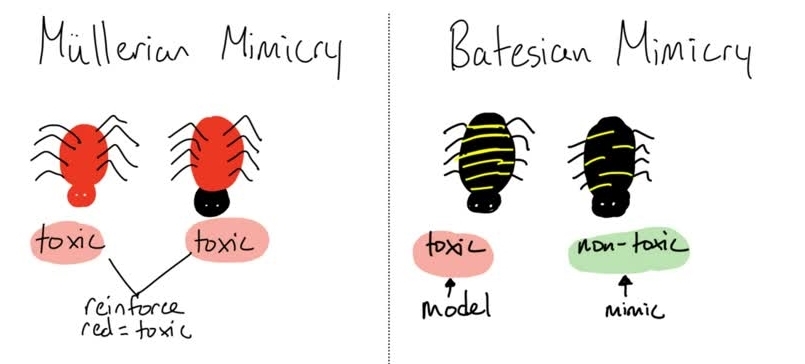Community Ecology
In part 1, we defined a community to be many different populations of different species living in the same area at once. Community ecology describes the interactions between these populations. Interspecific competition is competition between different species. Some principles apply to this type of competition:
- Gause's principal (competitive exclusion principle) states that when two populations are competing for the same resources because they are in the same niche, one of the populations is more likely to be successful than the other. Only one of the two species will survive, while the other will die. In other words, two species competing for the same resources cannot coexist forever.
- Resource partitioning is when two species can coexist in the same environment. This seems like it violates Gause's principal, but what really happens is that the two populations start to occupy slightly different niches. This reduces the competition for resources. The species occupies its realized niche, which is different from its fundamental niche (the niche it is in without any competition). The realized niche is different from the fundamental niche and the two niches do not overlap.
- Character displacement (niche shift) is a direct result of resource partitioning. The population occupy different niches and over time, due to evolution, their physical characteristics also change to better match their realized niches. For example, if one type of finch occupied the realized niche that is only small seeds, while the other only fed on large seeds, the population that feeds on small seeds will evolve to have small beaks and the other population will evolve to have large beaks.
- Predation is another way in which communities can interact. There are different types of predators and their predation types:
- True predators kill and eat other animals. An example is lions.
- Parasites live on other organisms and obtain nutrients directly from the host. In the process, the host is weakened and slowly dies. In this time, the parasite usually completes more than one life cycle.
- Parasitoids are insects that lay eggs on the host. The eggs hatch and obtain nutrients directly from the host, like a parasite. The host usually dies after the larvae complete development.
- Herbivores are animals that only eat plants. Grazers eat grasses and leaves, while browsers only eat part of the plant, but weaken the plant in the process.

Two species that live together in the same environment can have different relationships. Symbiosis refers to these types of relationships. The relationship can have differing effects on each of the two species depending on the relationships between them.
- Mutualism is when both species benefit from the relationship. For example, acacia trees provide housing and food for ants, and in return, ants kill fungi and insects on the tree. This benefits both species.
- Commensalism is when one species benefits, while the other is neither harmed nor helped. For example, birds build nests in trees. The tree provides housing for the birds' young, but the tree is not helped or harmed by the birds.
- Parasitism is when the parasite benefits, while the other organism is harmed. For example, tapeworms benefit from being inside an animal's digestive tract. The tapeworm steals nutrients from the host, causing the host to be harmed.
Additional examples are shows in the image below.

Coevolution
Coevolution describes the changing predator-prey relationships. As prey evolve to evade predators and acquire characteristics to defend themselves from predators, predators must allow evolve to capture the evasive prey. Basically, coevolution is the evolution of predators to easily capture prey as prey evolve. There are different methods of coevolution:
- Secondary compounds are toxic substances that plants produce to discourage herbivores from feeding on them.
- Camouflage/cryptic coloration is a type of coloration used by an animal to blend in with their surroundings. This allows them to hide from predators or prey (both types can benefit).
- Aposematic coloration/warning coloration is a pattern on the skin of animals that warns predators that the animal is undesirable and should be avoided. Animals also use mimicry to take advantage of this coloration.
- Mimicry
- Müllerian mimicry is when multiple animals that are poisonous or undesirable have the same coloration. This makes is more likely that predators avoid all animals of this coloration. For example, if a predator was to eat a frog with red and yellow stripes and learn that it tasted bad, the predator would be more likely to avoid all animals with red and yellow stripes. The predator will not know that an animal with blue and yellow stripes is also undesirable and will eat the animal. If the blue and yellow striped animal has red and yellow stripes instead, the predator would have avoided it.
- Batesian mimicry is when an animal that doesn't have any defense mechanism (such as poison) has the same coloration as an animal that is undesirable. Building on the example used in Müllerian mimicry, an animal that has red and yellow stripes but is not poisonous will also be avoided by the predator (who doesn't know that the animal is safe to eat).
- Pollination occurs in flowers. Flowers have a distinct set of characteristics that cause their pollinators to come to the flower.

